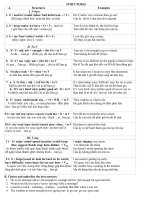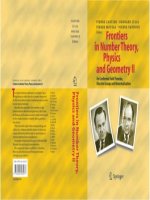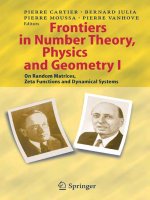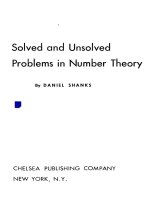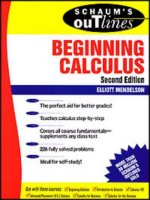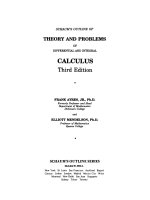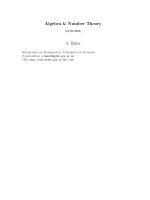NUMBER THEORY Structures, Examples, and Problems
Bạn đang xem bản rút gọn của tài liệu. Xem và tải ngay bản đầy đủ của tài liệu tại đây (1.79 MB, 414 trang )
i
”God made the integers, all else is the work of man.”
Leopold Kronecker
ii
NUMBER THEORY
Structures, Examples, and Problems
Titu Andreescu Dorin Andrica
ii
Contents
Foreword 7
Acknowledgments 9
Notation 11
I STRUCTURES, EXAMPLES,
AND PROBLEMS 13
1 Divisibility 15
1.1 Divisibility . . . . . . . . . . . . . . . . . . . . . . . . . . . 15
1.2 Prime numbers . . . . . . . . . . . . . . . . . . . . . . . . . 21
1.3 The greatest common divisor . . . . . . . . . . . . . . . . . 30
1.4 Odd and even . . . . . . . . . . . . . . . . . . . . . . . . . . 39
1.5 Modular arithmetics . . . . . . . . . . . . . . . . . . . . . . 42
1.6 Chinese remainder theorem . . . . . . . . . . . . . . . . . . 47
1.7 Numerical systems . . . . . . . . . . . . . . . . . . . . . . . 50
1.7.1 Representation of integers in an arbitrary base . . . 50
1.7.2 Divisibility criteria in the decimal system . . . . . . 51
2 Contents
2 Powers of Integers 61
2.1 Perfect squares . . . . . . . . . . . . . . . . . . . . . . . . . 61
2.2 Perfect cubes . . . . . . . . . . . . . . . . . . . . . . . . . . 70
2.3 k
th
powers of integers, k ≥ 4 . . . . . . . . . . . . . . . . . . 72
3 Floor Function and Fractional Part 77
3.1 General problems . . . . . . . . . . . . . . . . . . . . . . . . 77
3.2 Floor function and integer points . . . . . . . . . . . . . . . 83
3.3 An useful result . . . . . . . . . . . . . . . . . . . . . . . . . 88
4 Digits of Numbers 91
4.1 The last digits of a number . . . . . . . . . . . . . . . . . . 91
4.2 The sum of the digits of a number . . . . . . . . . . . . . . 94
4.3 Other problems involving digits . . . . . . . . . . . . . . . . 100
5 Basic Principles in Numb er Theory 103
5.1 Two simple principles . . . . . . . . . . . . . . . . . . . . . 103
5.1.1 Extremal arguments . . . . . . . . . . . . . . . . . . 103
5.1.2 Pigeonhole principle . . . . . . . . . . . . . . . . . . 105
5.2 Mathematical induction . . . . . . . . . . . . . . . . . . . . 108
5.3 Infinite descent . . . . . . . . . . . . . . . . . . . . . . . . . 113
5.4 Inclusion-exclusion . . . . . . . . . . . . . . . . . . . . . . . 115
6 Arithmetic Functions 119
6.1 Multiplicative functions . . . . . . . . . . . . . . . . . . . . 119
6.2 Number of divisors . . . . . . . . . . . . . . . . . . . . . . . 126
6.3 Sum of divisors . . . . . . . . . . . . . . . . . . . . . . . . . 129
6.4 Euler’s totient function . . . . . . . . . . . . . . . . . . . . . 131
6.5 Exponent of a prime and Legendre’s formula . . . . . . . . 135
7 More on Divisibility 141
7.1 Fermat’s Little Theorem . . . . . . . . . . . . . . . . . . . . 141
7.2 Euler’s Theorem . . . . . . . . . . . . . . . . . . . . . . . . 147
7.3 The order of an element . . . . . . . . . . . . . . . . . . . . 150
7.4 Wilson’s Theorem . . . . . . . . . . . . . . . . . . . . . . . 153
8 Diophantine Equations 157
8.1 Linear Diophantine equations . . . . . . . . . . . . . . . . . 15 7
8.2 Quadratic Diophantine equations . . . . . . . . . . . . . . . 161
Contents 3
8.2.1 Pythagorean equation . . . . . . . . . . . . . . . . . 161
8.2.2 Pell’s equation . . . . . . . . . . . . . . . . . . . . . 164
8.2.3 Other quadratic equations . . . . . . . . . . . . . . . 169
8.3 Nonstandard Diophantine equations . . . . . . . . . . . . . 171
8.3.1 Cubic equations . . . . . . . . . . . . . . . . . . . . . 171
8.3.2 High-order polynomial equations . . . . . . . . . . . 173
8.3.3 Exponential Diophantine equations . . . . . . . . . . 176
9 Some spe cial problems in number theory 179
9.1 Quadratic residues. Legendre’s symbol . . . . . . . . . . . . 179
9.2 Special numbers . . . . . . . . . . . . . . . . . . . . . . . . 188
9.2.1 Fermat’s numbers . . . . . . . . . . . . . . . . . . . . 188
9.2.2 Mersenne’s numbers . . . . . . . . . . . . . . . . . . 191
9.2.3 Perfect numbers . . . . . . . . . . . . . . . . . . . . . 192
9.3 Sequences of integers . . . . . . . . . . . . . . . . . . . . . . 193
9.3.1 Fibonacci and Lucas sequences . . . . . . . . . . . . 193
9.3.2 Problems involving linear recursive relations . . . . . 197
9.3.3 Nonstandard sequences of integers . . . . . . . . . . 204
10 Problems Involving Binomial Coefficients 211
10.1 Binomial coefficients . . . . . . . . . . . . . . . . . . . . . . 211
10.2 Lucas’ and Kummer’s Theorems . . . . . . . . . . . . . . . 218
11 Miscel laneous Problems 223
II SOLUTIONS TO PROPOSED PROBLEMS 229
12 Divisibility 231
12.1 Divisibility . . . . . . . . . . . . . . . . . . . . . . . . . . . 231
12.2 Prime numbers . . . . . . . . . . . . . . . . . . . . . . . . . 237
12.3 The gre atest c ommon divisor . . . . . . . . . . . . . . . . . 242
12.4 Odd and even . . . . . . . . . . . . . . . . . . . . . . . . . . 247
12.5 Modular arithmetics . . . . . . . . . . . . . . . . . . . . . . 248
12.6 Chinese rema inder theorem . . . . . . . . . . . . . . . . . . 251
12.7 Numerical systems . . . . . . . . . . . . . . . . . . . . . . . 253
13 Powers of Integers 261
13.1 Perfect squares . . . . . . . . . . . . . . . . . . . . . . . . . 261
4 Contents
13.2 Perfect cubes . . . . . . . . . . . . . . . . . . . . . . . . . . 270
13.3 k
th
powers of integers, k ≥ 4 . . . . . . . . . . . . . . . . . . 2 72
14 Floor Function and Fractional Part 275
14.1 General problems . . . . . . . . . . . . . . . . . . . . . . . . 275
14.2 Floor function and integer points . . . . . . . . . . . . . . . 279
14.3 An useful result . . . . . . . . . . . . . . . . . . . . . . . . . 280
15 Digits of Numbers 283
15.1 The last digits of a number . . . . . . . . . . . . . . . . . . 283
15.2 The sum of the digits of a number . . . . . . . . . . . . . . 284
15.3 Other problems involving digits . . . . . . . . . . . . . . . . 288
16 Basic Principles in Number Theory 291
16.1 Two simple principles . . . . . . . . . . . . . . . . . . . . . 291
16.2 Mathematical induction . . . . . . . . . . . . . . . . . . . . 294
16.3 Infinite descent . . . . . . . . . . . . . . . . . . . . . . . . . 300
16.4 Inclusion-exclus ion . . . . . . . . . . . . . . . . . . . . . . . 301
17 Arithmetic Functions 305
17.1 Multiplicative functions . . . . . . . . . . . . . . . . . . . . 305
17.2 Number of divisors . . . . . . . . . . . . . . . . . . . . . . . 307
17.3 Sum of divisors . . . . . . . . . . . . . . . . . . . . . . . . . 309
17.4 Euler’s totient function . . . . . . . . . . . . . . . . . . . . . 311
17.5 Exponent of a prime and Legendre’s formula . . . . . . . . 3 13
18 More on Divisibility 319
18.1 Fermat’s Little Theorem . . . . . . . . . . . . . . . . . . . . 319
18.2 Euler’s Theor e m . . . . . . . . . . . . . . . . . . . . . . . . 326
18.3 The order of an element . . . . . . . . . . . . . . . . . . . . 328
18.4 Wilson’s Theorem . . . . . . . . . . . . . . . . . . . . . . . 330
19 Diophantine Equations 333
19.1 Linear Diophantine equations . . . . . . . . . . . . . . . . . 3 33
19.2 Quadr atic Diophantine equations . . . . . . . . . . . . . . . 336
19.2.1 Pythagorean equations . . . . . . . . . . . . . . . . 336
19.2.2 Pell’s equation . . . . . . . . . . . . . . . . . . . . . 337
19.2.3 Other quadratic equations . . . . . . . . . . . . . . 340
19.3 Nonstandard Diophantine equations . . . . . . . . . . . . . 343
Contents 5
19.3.1 Cubic equations . . . . . . . . . . . . . . . . . . . . 343
19.3.2 High-order polynomial equations . . . . . . . . . . . 345
19.3.3 Exponential Diophantine equations . . . . . . . . . 347
20 Some special problems in number theory 351
20.1 Quadr atic residues. Legendre’s symbol . . . . . . . . . . . . 351
20.2 Special numbers . . . . . . . . . . . . . . . . . . . . . . . . 354
20.2.1 Fermat’s numbers . . . . . . . . . . . . . . . . . . . 354
20.2.2 Mersenne’s numbers . . . . . . . . . . . . . . . . . . 356
20.2.3 Perfect numbers . . . . . . . . . . . . . . . . . . . . 3 57
20.3 Sequences of integers . . . . . . . . . . . . . . . . . . . . . . 357
20.3.1 Fibonacci and Lucas sequences . . . . . . . . . . . . 357
20.3.2 Problems involving linear recursive relations . . . . 360
20.3.3 Nonstandar d sequences of integers . . . . . . . . . . 364
21 Problems Involving Binomial Coefficients 379
21.1 Binomial coefficients . . . . . . . . . . . . . . . . . . . . . . 379
21.2 Lucas’ and Kummer’s Theorems . . . . . . . . . . . . . . . 384
22 Miscel laneous Problems 387
Glossary 393
References 401
Index of Authors 407
Subje ct Index 409
6 Contents
Foreword
One of the oldest and liveliest branches of mathematics, Number The-
ory, is noted for its theoretical depth and applications to other fields, in-
cluding representation theory, physics, and cryptogra phy. The forefront of
Number Theory is replete with sophisticated and famous open problems;
at its foundation, however, are basic, elementary ideas that can stimulate
and challenge beg inning students. This textbook takes a problem-solving
approach to Number Theory, situating each theoretical concept within
the framework of some examples or some problems for readers to solve.
Starting with the essentials, the text covers divisibility, powers of inte-
gers, floor function and fractional part, digits of numbers, basic methods
of proof (extremal arguments, pigeonhole principle, induction, infinite de-
scent, inclusion-exclusion), arithmetic function, important divisibility the-
orems and Diophantine equations. Emphasis is also placed on the pre-
sentation of some special problems involving quadratic residues, Fermat,
Mersenne, and perfect numbers, as well as famous sequences of integers
such as Fibonacci, Lucas, and other important ones defined by recursive
relations. By thoroughly discussing interesting examples and applications
and by introducing and illustrating every key idea, by relevant problems of
various levels of difficulty, the bo ok motivates, engages and challenges the
8 Foreword
reader. The exposition proc e e ds incrementally, intuitively and rigorous ly
uncovers deeper proper ties.
A special feature of the book is an outstanding selection of genuine
Olympiad a nd other important mathematical contest problems solved us-
ing the methods already presented. The book brings about the unique and
vast experience of the authors. It captures the spirit of an impo rtant math-
ematical literature and distills the essence of a rich problem-solving culture.
”Number Theory: Structures, Examples and Problems” will appea l to
senior high school and undergraduate students, their instructors, as well as
to all who would like to expand their mathematical horizons. It is a sour c e
of fascinating problems for readers at all levels and widely opens the gate
to further explorations in mathematics.
Acknowledgments
Many problems are either inspired by or adapted from various mathemat-
ical contests in different countries. We expres s our deepest appreciation to
the original proposers of the problems. Special thanks are given to Gabriel
Dospinescu (Ecole Normale Superieure Paris, France) for the ca reful proof
reading of the manuscript and for many helpful suggestions .
10 Acknowledgments
Notation
Z the set of integers
Z
n
the set of integers modulo n
N the set of positive integers
N
0
the set of nonnegative integers
Q the set of rational numbers
Q
+
the set of positive rational numbers
Q
0
the set of nonnegative rational numbers
Q
n
the set of n-tuples of rational numbe rs
R the set of real numbers
R
+
the set of positive real numbers
R
0
the set of nonnegative rea l number s
R
n
the set of n-tuples of real number s
C the set of complex numbers
|A| the number of elements in the set A
A ⊂ B A is a proper subset of B
A ⊆ B A is a subset of B
A \ B A without B (set difference)
A ∩ B the intersection of sets A and B
A ∪ B the union of sets A and B
a ∈ A the element a belongs to the set A
12 Notation
n|m n divides m
gcd(m, n) the greatest common divisor of m, n
lcm(m, n) the least common multiple of m, n
π(n) the number of primes ≤ n
τ(n) number of divisors of n
σ(n) sum of positive divisors of n
a ≡ b (mod m) a and b are congruent modulo m
ϕ Euler’s totient function
ord
m
(a) order of a modulo m
µ M¨obius function
a
k
a
k−1
. . . a
0
(b)
base b representation
S(n) the sum of digits of n
(f
1
, f
2
, . . . , f
m
) factor ial base expansion
⌊x⌋ floor of x
⌈x⌉ celling of x
{x} fractional part of x
e
p
Legendre’s function
p
k
n p
k
fully divides n
f
n
Fermat’s number
M
n
Mersenne’s number
a
p
Legendre’s symbol
F
n
Fibo nacci’s number
L
n
Lucas’ number
P
n
Pell’s number
n
k
binomial coefficient
Part I
STRUCTURES,
EXAMPLES,
AND PROBLEMS
13
1
Divisibility
1.1 Divisibil ity
For integers a and b, a = 0, we say that a divides b if b = ac for some
integer c. We denote this by a|b. We also say that b is divis ible by a or that
b is a multiple of a.
Because 0 = a ·0, it follows that a|0 for all integers a, a = 0.
Straight from the definition we can derive the following properties:
1. If a|b, b = 0, then |a| ≤ |b|;
2. If a|b and a|c, then a|αb + βc for any integers α and β;
3. If a|b and a|b ± c, then a|c;
4. a|a (reflexivity);
5. If a|b and b|c, then a|c (transitivity);
6. If a|b and b|a, then |a| = |b|.
The following result is called the Division Algor ithm and it plays an
impo rtant role:
Theorem. For any positive integers a and b there exists a unique pair
(q, r) of nonnegative integers such that
b = aq + r, r < a.
Proof. If a > b, then q = 0 and r = b < a.
16 1. DIVISIBILITY
If a = b, then q = 1 and r = 0 < a.
If a < b, then there exist pos itive integers n such that na > b. Let q be
the least positive integer for which (q+1)a > b. Then qa ≤ b. Let r = b−aq.
It follows that b = aq + r and 0 ≤ r < a.
For the uniqueness, assume that b = aq
′
+ r
′
, where q
′
and r
′
are also
nonnegative integers satisfying 0 ≤ r
′
< a. Then aq + r = aq
′
+ r
′
, implying
a(q −q
′
) = r
′
−r, and so a|r
′
−r. Hence |r
′
−r| ≥ a or |r
′
−r| = 0. Be c ause
0 ≤ r, r
′
< a yields |r
′
− r| < a, we are left with |r
′
− r| = 0, implying
r
′
= r and, consequently, q
′
= q.
In the theorem above, when a is divided by b, q is called the quotient
and r the remainder.
Remark. The Division Algorithm can be extended for integers as fol-
lows: For a ny integers a and b, a = 0, there exists a unique pair (q, r) of
integers such that
b = aq + r, 0 ≤ r < |a|.
Example. Prove that for all positive integers n, the fraction
21n + 4
14n + 3
is irreducible.
(1
st
IMO)
Indeed, from the equality
2(21n + 4) − 3(14n + 3) = −1
it follows that 2 1n + 4 and 14n + 3 have no common diviso r except for 1,
hence the conclusion.
Problem 1.1.1. Prove that for all integers n:
a) n
5
− 5n
3
+ 4n is divisible by 120;
b) n
2
+ 3n + 5 is not divisible by 121.
Solution. a) n
5
− 5n
3
+ 4n = n(n
2
− 1)(n
2
− 4)
= n(n − 1)(n + 1)(n − 2)(n + 2),
the product of five consecutive integers: n − 2, n − 1, n, n + 1, n + 2.
If n ∈ {−2, −1, 0, 1, 2} we get n
5
−5n
3
+ 4n = 0 and the property holds.
If n ≥ 3 we can write
n
5
− 5n
3
+ 4n = 5!
n + 2
5
= 120
n + 2
5
,
1.1. DIVISIBILITY 17
and the conclusion follows.
If n ≤ −3, write n = −m, where m ≥ 3, and obtain
n
5
− 5n
3
+ 4n = −120
m + 2
5
,
and we are done.
b) Observe that
n
2
+ 3n + 5 = (n + 7)(n −4) + 33,
so that 11|n
2
+3n+5 if and only if 11|(n+7)(n−4). Thus, if 11 ∤ (n+7)(n−4)
then 11 (and hence 121) does not divide n
2
+ 3n +5. So, a ssume 11 divides
(n + 7)(n − 4). Then 11|n + 7 or 11|n − 4; but then 11 must divide both
of n + 7 and n − 4, since (n + 7) −(n −4) = 11. Thus, 121|(n + 7 )(n −4).
However, 121 ∤ 33. So 121 ∤ n
2
+ 3n + 5 = (n + 7)(n −4) + 33. Hence, in all
cases, 121 ∤ n
2
+ 3n + 5.
Problem 1.1.2. Let p > 2 be an odd number and let n be a positive
integer. Prove that p divides 1
p
n
+ 2
p
n
+ ··· + (p −1)
p
n
.
Solution. Define k = p
n
and note that k is odd. Then
d
k
+ (p −d)
k
= p[d
k−1
− d
k−2
(p − d) + ···+ (p −d)
k−1
]
Summing up the equalities from d = 1 to d =
p − 1
2
implies that p divides
1
k
+ 2
k
+ ··· + (p −1)
k
, as claimed.
Problem 1.1.3. Prove that
3
4
5
+ 4
5
6
is a product of two integers, each of which is larger than 10
2002
.
Solution. The given number is of the form m
4
+
1
4
n
4
, where m = 3
4
4
and
n = 4
5
6
+1
4
= 2
5
6
+1
2
.
The conclusion follows from the identity
m
4
+
n
4
4
= m
4
+ m
2
n
2
+
1
4
n
4
− m
2
n
2
=
m
2
+
1
2
n
2
2
− m
2
n
2
=
=
m
2
+ mn +
1
2
n
2
m
2
− mn +
1
2
n
2
,
18 1. DIVISIBILITY
where n is even so
n
2
2
is an integer, and from the inequalities:
m
2
− mn +
1
2
n
2
=
m −
n
2
2
+
n
2
4
>
n
2
4
= 2
5
6
−1
> 2
10008
> (2
4
)
2002
> 10
2002
.
Problem 1.1.4. Find all positive integers n su ch that for all odd integers
a, if a
2
≤ n then a|n.
Solution. Let a be the greatest odd integer such that a
2
< n, hence
n ≤ (a + 2)
2
. If a ≥ 7, then a −4, a −2, a are odd integers which divide n.
Note that any two of these numbers are relatively prime, so (a −4)(a −2)a
divides n. It follows that (a − 4)(a − 2)a ≤ (a + 2)
2
so a
3
− 6a
2
+ 8a ≤
a
2
+ 4a + 4. Then a
3
− 7a
2
+ 4a − 4 ≤ 0 or a
2
(a −7) + 4(a − 1) ≤ 0. This
is false, because a ≥ 7, hence a = 1, 3 or 5.
If a = 1, then 1
2
≤ n ≤ 3
2
, so n ∈ {1, 2, . . ., 8}.
If a = 3, then 3
2
≤ n ≤ 5
2
and 1 · 3|n, so n ∈ {9, 12, 15, 18, 21, 24}.
If a = 5, then 5
2
≤ n ≤ 7
2
and 1 · 3 · 5|n so n ∈ {30, 45}. Therefo re
n ∈ {1, 2, 3, 4, 5, 6, 7, 8, 9, 12, 15, 18, 21, 24, 30, 45}.
Problem 1.1.5. Find the elements of the set
S =
x ∈ Z|
x
3
− 3x + 2
2x + 1
∈ Z
.
Solution. Since
x
3
− 3x + 2
2x + 1
∈ Z, then
8x
3
− 24x + 16
2x + 1
= 4x
2
− 2x − 11 +
27
2x + 1
∈ Z.
It follows that 2x + 1 divides 27, so
2x + 1 ∈ {±1, ±3, ±9, ±27} and x ∈ {−14, −5, −2, −1, 0, 1, 4, 13},
since 2x + 1 is odd,
x
3
− 3x + 2
2x + 1
∈ Z ⇔
8x
3
− 24x + 16
2x + 1
∈ Z, so all these
are solutions.
Problem 1.1.6. Find all positive integers n for which the number ob-
tained by erasing the last digit is a divisor of n.
Solution. Let b be the last digit of the number n and let a be the number
obtained from n by erasing the last digit b. Then n = 10a + b. Since a is
a divisor of n, we infer that a divides b. Any number n that ends in 0 is
1.1. DIVISIBILITY 19
therefore a solution. If b = 0, then a is a digit and n is one of the numbers
11, 12,. . . , 19, 22, 24, 26, 28, 33, 36, 39, 44, 48, 55, 56, 77, 88 or 99.
Problem 1.1.7. Find the greatest positive integer x such that 23
6+x
divides 2000!.
Solution. The number 23 is prime and divides every 23
rd
number. In
all, there are
2000
23
= 86 numb ers from 1 to 2000 that are divisible by
23. Among those 86 numbers, three of them, namely 23, 2 · 23 and 3 · 23
2
are divisible by 23
3
. Hence 23
89
|2000! and x = 89 − 6 = 83.
Problem 1.1.8. Find the positive integers n with exactly 12 divisors
1 = d
1
< d
2
< ··· < d
12
= n such that the divisor with index d
4
(that is,
d
d
4
− 1) is (d
1
+ d
2
+ d
4
)d
8
.
(1989 Russian Mathematical Olympiad)
Solution. Of course, there is 1 ≤ i ≤ 12 such that d
i
= d
1
+d
2
+d
4
. Since
d
i
> d
4
, we have i ≥ 5. Also, observe tha t d
j
d
13−j
= m for all j and since
d
i
d
8
= d
d
4
−1
≤ n, we must have i ≤ 5, thus i = 5 and d
1
+ d
2
+ d
4
= d
5
.
Also, d
d
4
−1
= d
5
d
8
= n = d
12
, thus d
4
= 13 and d
5
= 14 + d
2
. Of course,
d
2
is the smallest prime divisor of n and since d
4
= 13, we can only have
d
2
∈ {2, 3, 5, 7, 11}. Also, since n has 12 divisor s, it has at most 3 prime
divisors. If d
2
= 2 then d
5
= 16 and then 4 and 8 are divisors of n, smaller
than d
4
= 13, impossible. A similar argument shows that d
2
= 3 and
d
5
= 17. Since n has 12 divisors and is a multiple of 3 · 13 · 17, the only
possibilities are 9 ·13 ·17, 3 ·1697 or 3 ·13 ·289. One can easily check that
only 9 · 13 · 17 = 1989 is a solution.
Problem 1. 1.9. Let n be a positive integer. Show that any num ber
greater than n
4
/16 can be written in at most one way as the product of
two of its divisors having difference not exceeding n.
(1998 St. Petersburg City Mathematical Olympiad)
First Solution. Suppose, on the contrary, that there exist a > c ≥ d > b
with a − b ≤ n and ab = cd > n
4
/16. Put p = a + b, q = a −b, r = c + d,
s = c −d. Now
p
2
− q
2
= 4ab = 4cd = r
2
− s
2
> n
4
/4.
Thus p
2
−r
2
= q
2
−s
2
≤ q
2
≤ n
2
. But r
2
> n
4
/4 (so r > n
2
/2) and p > r,
so
p
2
− r
2
> (n
2
/2 + 1)
2
− (n
2
/2)
2
≥ n
2
+ 1,
20 1. DIVISIBILITY
a contradiction.
Second solution. Again, supp ose that ab = cd > n
4
/16, with a > c, d
and n ≥ a −b. If we let p = gcd(a, c), we can find positive integers p, q, r, s
such that a = pq, b = rs, c = pr, d = qs. Then a > c ⇒ q > r and
a > d ⇒ p > s, so that
n ≥ pq − rs
≥ (s + 1)(r + 1) −rs
= r + s + 1
≥ 2
√
b + 1.
Thus b ≤
n − 1
2
2
< n
2
/4, and a ≤
n − 1
2
2
+ n =
n + 1
2
2
.
Therefore ab ≤
n
2
− 1
4
2
< n
4
/16, a contradiction.
Proposed problems
Problem 1.1.10. Show that for any natural number n, between n
2
and
(n+ 1)
2
one can find three distinct natural numbers a, b, c such that a
2
+ b
2
is divisible by c.
(1998 St. Petersburg City Mathematical Olympiad)
Problem 1.1.11. Find all odd positive integers n greater than 1 such
that for any relatively prime divisors a and b of n, the number a + b −1 is
also a divisor of n.
(2001 Russian Mathematical Olympiad)
Problem 1.1.12. Find all positive integers n such that 3
n−1
+ 5
n−1
divides 3
n
+ 5
n
.
(1996 St. Petersburg City Mathematical Olympiad)
Problem 1.1.13. Find all positive integers n such that the set
{n, n + 1, n + 2, n + 3, n + 4, n + 5}
can be split into two disjoint subsets such that the products of elements in
these subsets are the same.
(12
th
IMO)
1.2. PRIME NUMBERS 21
Problem 1.1.14. The positive integers d
1
, d
2
, . . . , d
n
divide 1995. Prove
that there exist d
i
and d
j
among them, such that the numerator of the
reduced fraction d
i
/d
j
is at least n.
(1995 Israeli Mathematical Olympiad)
Problem 1.1.15. Determine all pa irs (a, b) of positive integers such that
ab
2
+ b + 7 divides a
2
b + a + b.
(39
th
IMO)
Problem 1.1.16. Find all integers a, b, c with 1 < a < b < c such that
(a − 1)(b − 1)(c − 1) is a divisor of abc −1.
(33
rd
IMO)
Problem 1.1.17. Find all pairs of positive integers (x, y) for which
x
2
+ y
2
x − y
is an integer which divides 1995.
(1995 Bulgarian Mathematical Olympiad)
Problem 1.1.18. Find all positive integers (x, n) such that x
n
+ 2
n
+ 1
is a divisor of x
n+1
+ 2
n+1
+ 1.
(1998 Romanian IMO Team Selection Test)
Problem 1.1.19. Find the s mallest positive integer K such that e very
K-element subset of {1, 2, . . . , 50} contains two distinct elements a, b such
that a + b divides ab.
(1996 Chinese Mathematical Olympiad)
1.2 Prime numbers
The integer p > 1 is called a prime if there is no integer d > 1 such that
d|p. Any integer n > 1 has at least a prime divisor. If n is a prime, then
that prime divisor is n itself. If n is not a prime, then let a > 1 be its
least divisor. Then n = ab, where 1 < a ≤ b. If a were no t a prime, then
a = a
1
a
2
with 1 < a
1
≤ a
2
< a and a
1
|n, contradicting the minimality of
a.
